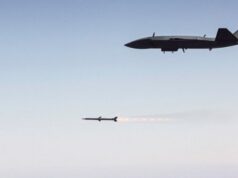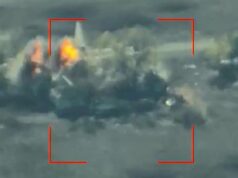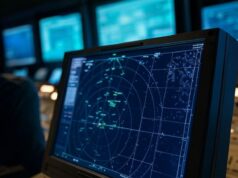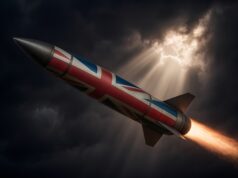The US designed E-3D Sentry AEW.Mk 1 is an airborne early warning (AEW) and command and control aircraft in British service, but what does that mean?
The Sentry monitors airspace to provide threat detection of adversary aircraft and situational awareness on friendly assets.
Information gathered by the Northrop Grumman APY-2 radar is processed by the mission crew and disseminated via a variety of data links and communication systems. Sentry also has the capability to detect ships, relaying information to maritime aircraft or allied vessels for further investigation.
Its electronic support measures equipment enables the E-3D to gather emissions from other radar systems and emitters, enhancing the crew’s understanding of the environment in which it is operating.
Modified with a Westinghouse AN/APY-1 radar system, its antenna covered by a massive rotating radome held over the rear fuselage, the first of two EC-137D prototypes completed its initial flight on February 5, 1972. After an extensive test programme, the E-3A production version entered service in March 1977. Although the type is officially named ‘Sentry’, the USAF designates it E-3 AWACS.
Officially designated Sentry AEW.Mk 1 in RAF service, but commonly known as E-3D, the new aircraft differed from the US fleet in its powerplant of more efficient CFM56 engines.
Today the Sentry is fully integrated into the ISTAR Force, yet retains its core competencies of airborne early warning and airspace management.
The 2015 Strategic Defence and Security Review called for Sentry to remain in service until 2035.













and not a mention of the ‘N’ word! By all accounts, dated avionics now and it has fallen behind the NATO fleet.
Good point, the RAF didn’t follow the US ,French or Saudi Arabians when they upgraded theirs a few years ago. RUSI has this to say:
“The RAF’s E-3Ds need a £2-billion CSP both to bring them to rough parity with current US and French standards by the mid-2020s and to stretch the fleet out to 2035 in the process. However, the E-3, even in modernised form, is no longer a cutting-edge ABM&S system in a world where proliferating long-range missile systems and emerging non-Western low-observable fighters can force it to stay hundreds of kilometres from contested airspace, placing a higher premium on BLOS communications capacity rather than onboard sensors.
Also in this age of saving money, the Government is looking at getting rid of them and finding something cheaper to have. That said in this day and age of Moores law systems such as the IAI EL/W-2085 and Erieye may be the future.
Doom, gloom, whinge, moan
https://rusi.org/publication/occasional-papers/future-air-c2-and-aew-e-3-sentry-threat-technologies-and-future
Nah, this present Government will simply sell them off in which to make some money and use the money saved in which to repair the concrete listening towers above south Kent. Well at least they are cheap to run
The N word …. Don’t mention the Spanish Inquisition!
Nobody expects……the Spanish Inquisition!
Farouk raises a great point re: Moores law,
Is it worth investing this much in long term system when technology is moving so quickly. Can we not get a “carrier vehicle” and add what is required in an open architecture way.
The cycles of Moores law are getting faster not slower and we need to find a way to manage this – perhaps a payload can be sorted for the voyagers if we can sort out if the requirements for that massive dome could be replaced with something like lightweight CEAFAR panels or such like.
I clearly don’t have the answers and it is not something I am at all familiar with.
The RAAFs Wedgetail E7’s fixed array MESA radars are the kind of cutting edge platform the RAF needs to invest in.
Interestingly the RAAF has the same number of operational E7s as the RAF has E3s.
https://www.airforce.gov.au/technology/aircraft/intelligence-surveillance-and-reconnaissance/e-7a-wedgetail
https://en.wikipedia.org/wiki/Boeing_737_AEW%26C
The E& is an integral part of the RAAFs growing electronic warfare capabilities, some of the best in the world.
http://www.thedrive.com/the-war-zone/12197/australia-set-to-become-one-of-the-worlds-top-aerial-electronic-warfare-powers?iid=sr-link4
Would it not just be cheaper and more effective … if a may say it … sensible …to procure a new AWACS airfraft based on A330 (I believe India have, or at least had, ordered a similar system). It would eliminate obsoleteness and could also share fleet support with Voyager (dare I say could use AirTankers support Facilities). Just food for thought really.
The future has to be with a joint aircraft capable of taking over from both the E3 and the Sentinel.
My usual approach, stick with the direction Uncle Sam is taking and get involved as a partner right off the drawing board.
The RAf purchased a total of 7 E3D’s after the BAe Nimrod AEW fiasco. I had heard a rumour that one aircraft was damaged in a ground incident and stored. Was this true and if so, can that account for only 6 E3D’s in present use. Any info?
That’s right I’m afraid, never repaired and used for spares.
Someone had to mention the N word!
you mean Northrop; the culprits for the 105 debacle?
http://www.flickr.com/photos/gsairpics/7473633166/